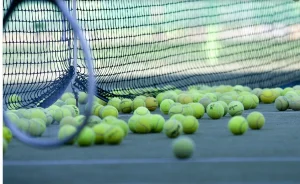In the world of tennis, where every match is a symphony of power, precision, and strategy, one element serves as the heartbeat of the game: the tennis ball. With every stroke, serve, and volley, the tennis ball dances across the court, dictating the rhythm and flow of play. But what secrets lie beneath its fuzzy exterior? Join us as we delve into the fascinating world of tennis ball dynamics and uncover the science behind its every bounce and spin.

The Anatomy of a Tennis Ball
Before we unravel the mysteries of tennis ball dynamics, let’s take a closer look at its anatomy. A standard tennis ball consists of several key components:
Rubber Core
At the heart of every tennis ball lies a pressurized rubber core. This core is responsible for the ball’s bounce and responsiveness on the court. The pressure within the core determines the ball’s firmness and liveliness, impacting its performance during play.
Felt Cover
Surrounding the rubber core is the iconic felt cover, which gives the tennis ball its distinctive appearance and texture. Made from a blend of wool and synthetic fibers, the felt cover provides grip and aerodynamic stability, allowing players to control the ball’s trajectory with precision.
The Science Behind Bounce and Spin
The behavior of a tennis ball in flight is governed by the laws of physics, with factors such as speed, angle, and surface interaction influencing its trajectory and spin. with factors such as speed, angle, and surface interaction influencing its trajectory and spin.
Bounce
When a tennis ball impacts the court surface, it undergoes deformation, compressing against the ground before rebounding with kinetic energy. The height and trajectory of the bounce depend on various factors, including the speed of the ball, the angle of impact, and the surface characteristics of the court. These specialized formulations take into account factors such as bounce, grip, and durability, ensuring that tennis balls perform consistently across different surfaces.
Spin
Spin is a crucial element of tennis ball dynamics, allowing players to manipulate the trajectory and behavior of the ball. Topspin shots generate a forward rotation that drives the ball downward, resulting in a higher bounce and sharper angle of descent. Conversely, backspin shots produce a backward rotation that causes the ball to float and skid low over the net. These specialized formulations take into account factors such as bounce, grip, and durability, ensuring that tennis balls perform consistently across different surfaces.
The Evolution of Tennis Ball Technology
Over the years, tennis ball technology has undergone significant advancements, driven by a desire to improve performance and durability. Manufacturers continually innovate to create balls that offer consistent bounce, optimal playability, and enhanced longevity.
Pressureless Balls
Pressureless tennis balls, which do not rely on internal air pressure, have gained popularity for their durability and longevity. These balls maintain their bounce and responsiveness over extended periods, making them ideal for practice sessions and recreational play.
High-Performance Cores
Advancements in rubber technology have led to the development of high-performance cores that offer superior bounce consistency and resilience. These cores ensure that tennis balls maintain their playability and responsiveness even after prolonged use.
Conclusion: The Artistry of Tennis Ball Dynamics
As players step onto the court, they enter a world where every stroke is a testament to the artistry of tennis ball dynamics. From the thud of the serve to the crack of the volley, the tennis ball orchestrates the symphony of the game with precision and grace. By unraveling the secrets behind its bounce and spin, players gain a deeper understanding of the sport and an appreciation for the intricacies that make tennis a true masterpiece of athleticism and skill.